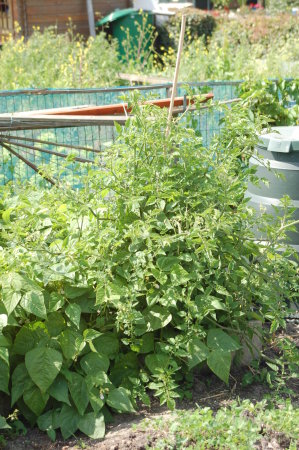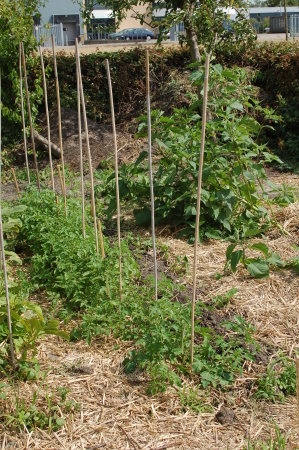I have the same tomato plants growing in two different parts of my garden. Both Matt’s Wild Cherry. The first picture you can see beans growing at the base of the plant:

Here in a different spot, on the three poles to the right, Matt’s Wild Cherry growing without beans:

In the background here you see my wind beaten Jerusalem artichokes, which by the way don’t seem to mind a shortage of nitrogen.
The poles are all the same size, about 180cm in total with about 1.5m sticking out above the ground.
You can see the tomato plants next to the beans are about 1 meter tall, and without the beans about 30cm. To be honest, I did put the 30cm plants out in the garden a few weeks later, but that still doesn’t account for the entire difference in size.
I posted before about the ground test I did, which showed my nitrogen levels were ‘medium-low to low’, at least in the one spot I did the test. It’s really becoming obvious just how low the overall nitrogen in my garden really is. I did the soil test first, then added compost, so I assumed that would help a little bit. I’ve also planted beans in several places.
What I’m seeing is anywhere a plant is not growing right next to a bean, it’s not doing very well.
I think because the nitrogen levels in the ground are so low, it’s contributing to the problem I mentioned in the last post about having ‘dead ground’, because all life needs nitrogen, and this in turn means the nutrients in the compost I added are becoming available to the plants only very slowly because there are no worms or insects to metabolize the compost.
Interestingly, my garlic is not showing signs of problems along these lines, but it’s hard to be completely sure.
With increasing urgency as I’ve been understanding what was going on I’ve been sowing beans through the garden, and most are germinating and growing by now. Bush beans mature in about 90 days, so there’s still plenty of season left for them. It’s clear as they begin to fix nitrogen, they are making a big difference to the neighboring plants. I’ve used up nearly my entire stock of bean seeds! The other problem I’ve been having is a minor water shortage, which I need to get the seeds to germinate, but fortunately we’ve been getting a little rain.
I don’t think there’s any real damage to the garden as a result, but a few things may not grow as large or produce as much in the end. The row of tiny tomatoes probably won’t produce much, but they aren’t very important. They are three different types of currant tomatoes that I was growing next to each other in order to compare them. I’ll be just as happy getting fruits a month late, and I don’t need very many.


That is a really interesting thing to have experimented with, Patrick, and is an excellent way of monitoring one of the things that can influence how plants like tomatoes grow.I might try it next time too.
My problem this winter is that my sugar snap peas aren’t growing as well as they normally do. I am a bit suspicious of the seeds being the problem (they were bought) because some other peas I got from a friend are doing much better. This is a pain in the neck and I wish I had saved more of my own peas last year and not eaten them all!Now it won’t be worth saving these seeds and I may have trouble getting some reliable peas going next year – when will it end? Nothing is ever straight forward in the vegetable garden, is it.